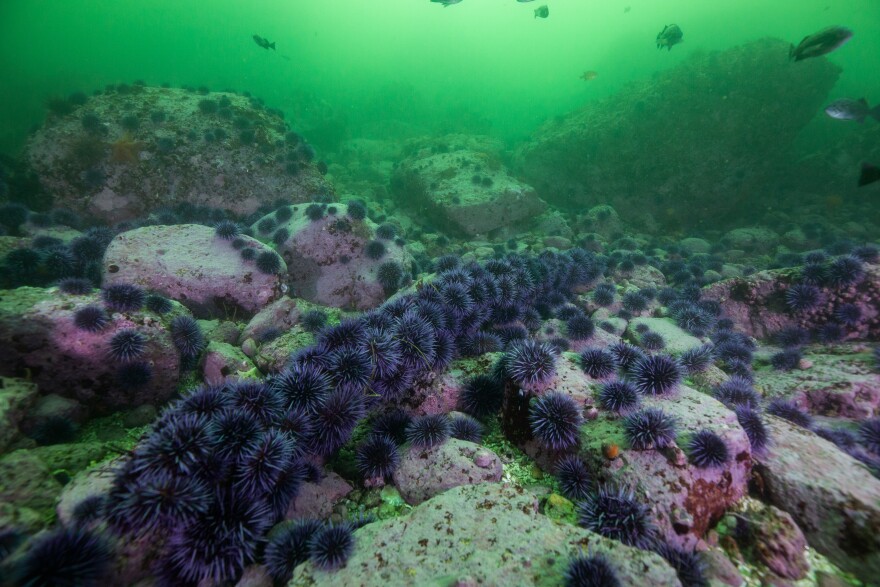California’s underwater kelp forests are in trouble. A combination of climate change and hungry purple sea urchins have decimated these vital forests. But the Monterey Peninsula has a kelp forest guardian — sea otters. New research out of the University of California, Santa Cruz is highlighting their role.

Josh Smith, a Ph.D. candidate at UC Santa Cruz, stands near a beach on Cannery Row in Monterey. The tops of kelp swirl in the calm current of the blue-green water. Just a decade ago, this area looked vastly different.
“The canopy would have spread out across this entire little bay,” said Smith. “Right now what we're seeing is a very patchy kelp forest.”
As a diver, the changes Smith saw underwater motivated him to research the role sea otters play in the complex story of disappearing kelp. The story begins around 2013. That’s when the number of purple sea urchins skyrocketed after a catastrophic sea star wasting syndrome wiped out one of the urchins’ main predators, the sunflower star.
Urchins eat kelp. The declining forest was further weakened by warming waters in 2014-2015, a symptom of climate change. Kelp needs cold water to survive. Urchins, who previously stayed in the crevices of reefs and consumed pieces of kelp that drifted down to them, began to emerge in search of food. Without sunflower stars, they started devouring live kelp.

These two factors resulted in Northern California losing 95 percent of its kelp forest in under a decade. The Monterey Bay area fared better, losing about 60 to 65 percent.
“One thing that our study has shown is that having predators like the sea otter are really important in helping to buffer this ecosystem from change,” Smith said.
The Ph.D. candidate says sea otters are slowing the decline of the local kelp forest by eating up urchins. In fact, they’re eating three times as many urchins as they used to. The abundance of food also meant the local sea otter population increased from about 270 otters to about 432 after 2014.
To collect data, Smith led more than 700 dive trips along the Monterey Peninsula. The team cumulatively spent about 500 hours underwater. Smith also worked with scientists from the Monterey Bay Aquarium and the U.S. Geological Survey who used telescopes and rangefinders to record what sea otters were eating and where.
“And one thing that's great about studying sea otters is they consume their prey at the surface. So we can watch an otter dive down and we can record where it came up and what it came up with,” said Smith.
The team’s findings were recently published in the journal Proceedings of the National Academy of Sciences. They found that otters ignore urchin barrens, areas where urchins have overgrazed kelp to the bare seafloor. The purple creatures there are starving and not nutritious; they’re often called zombie urchins. Instead, the otters focus on foraging the healthy ones in the remaining patches of kelp.

“Because sea otters are targeting urchins in these forests, they're helping to maintain the remnant patches of kelp forest that we actually have from overgrazing by sea urchins,” said Smith.
Otters live between Santa Barbara and just north of Santa Cruz. Further north from otter territory, urchins have no predators. And that’s possibly why the kelp forest decline is more severe in Northern California. Another factor, scientists say, may be the type of kelp. Bull kelp is dominant up north and giant kelp is dominant on the Central Coast.
Tristin McHugh is working to find solutions to save Northern California’s kelp forest. She’s the kelp project director for the Nature Conservancy.
“In Northern California, we don't have otters. We don't have lobsters, we don't have sheephead, we don't have sunflower stars. That really puts the pressure, currently, on humans to fill the role of that top predator,” said McHugh.
And she says that involves thinking broadly about progressive ways to approach climate issues moving forward. The Nature Conservancy is exploring several innovative ideas to reset and restore the ecosystem, including the use of urchin trapping to efficiently remove the spiny creatures. The nonprofit plans to test this method off Fort Bragg this spring. Also slated for this spring is the launch of an experimental in-ocean bull kelp farm with GreenWave and Humboldt State University. The pilot project will take place in Humboldt Bay.
“You’re basically seeding a field,” McHugh said. “But we have a few questions surrounding that. What techniques work best for bull kelp cultivation that focus on large scale restoration? And if successful, what are the benefits delivered by this type of cultivation?”
The Nature Conservancy is also exploring a captive breeding program for sunflower sea stars, a top predator of urchins.

As for the Monterey Bay, sea otters keep urchins with an insatiable taste for kelp in check. That’s something Dane Durand, who manages the Aquarius Dive Shop in Monterey, definitely appreciates. He describes diving in kelp like “flying through a forest.” And he says people from all over the world travel to Monterey to have that experience.
“We get people from England and all over Europe. I just had somebody from Iceland last week. So the kelp forest is something extremely special here,” said Durand.
Not only does the kelp forest support the local economy, it’s home to over 800 different animal species and helps remove carbon dioxide from the atmosphere.

Fortunately, the local kelp forest has guardians. UC Santa Cruz Ph.D. candidate Josh Smith says otters alone won’t save the kelp forest. But if something decreases the number of urchins in urchin barrens, such as a disease, otters have maintained patches of kelp that could replenish the entire forest.


